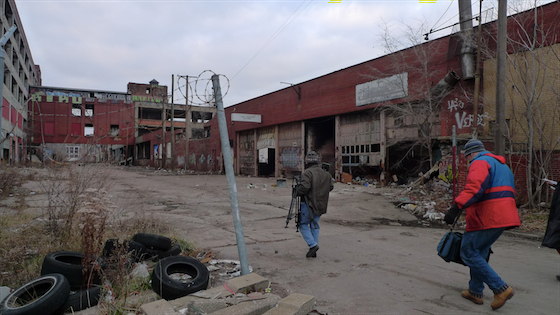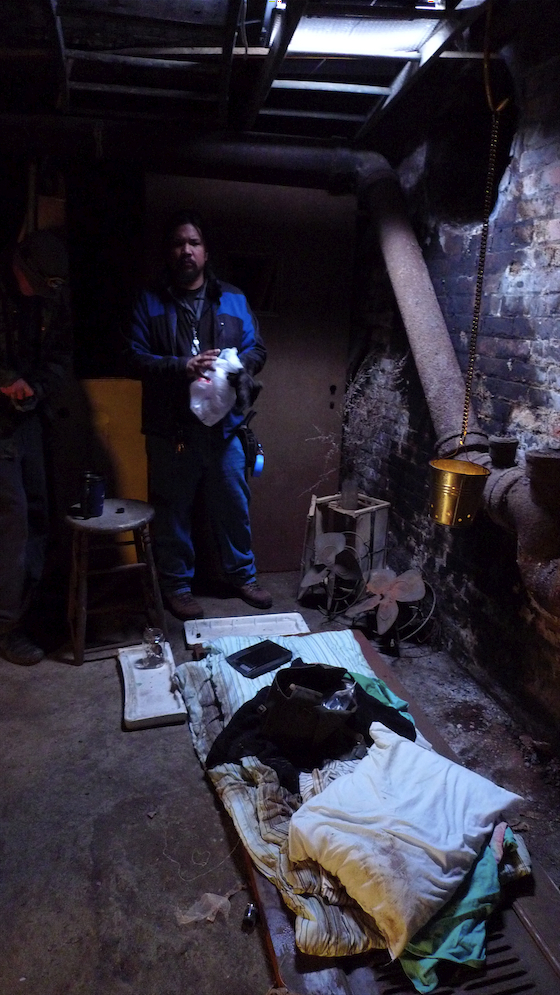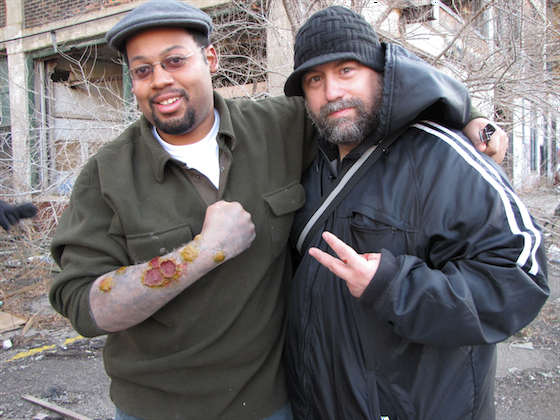If luck smiles on my schedule today, I hope to make it over to the Detroit Ice House. The managers of the project haven’t announced its location yet, so I won’t, either. But I know. It’s difficult to keep an abandoned house that has been carefully covered with ice much of a secret. They’ve surrounded the place with police tape, so the snow doesn’t get disturbed before the official project photographs are taken. Or so I’m told. It’s close enough for a quick lunchtime hop, and by then the temperature should be high enough that things should be a little drippy. High pressure promises preservative temperatures until the big reveal.
There are enough of these guerrilla art projects going on around here — a previous cadre of hipsters painted abandoned houses, from roof to foundation, including windows, in shades of safety orange and green — that I wonder if we’re on the tipping point of becoming a playground for this sort of thing. I once wrote that only in Detroit could a bartender become a real-estate developer, but now it’s even easier. In “The Farmer and the Philosopher,” the short film we saw the other night, Toby Barlow remarks that Detroit is a pretty big canvas. True dat. But I share Jim Griffioen’s oft-stated concern that poverty porn is not, in the end, a good thing, and attaching a food drive and other do-gooding to a project, while certainly worthy, can’t make it entirely right.
But I’ll reserve judgment until I see it. One of the very few conservative critiques of art I agree with is the idea that art shouldn’t have to come with a big explanation text, that when an artist has to post a signboard telling the viewer what he was after and whose blood the red paint signifies, the work has already failed. The Ice House may or may not “reference the contemporary urban conditions in the city and beyond,” as its blog states, but I do look forward to seeing it.
Which is a very long-winded way of saying, “I know what I like,” so there it is.
On Saturday, I’ll check out the Belle Isle Ice Tree, which makes no claims about urban conditions, other than, “Cold enough for you?”
I need to get out of the house, anyway. I’ve reached the stage of winter where feeling bad is a loop: I feel bad, so I skip workouts/eat too much/don’t get outdoors enough, which leads to more of the same. I should change my name to Ursa and just hibernate the season away, but then, who would dig up stuff to show you every day? Like…
Oh, the things you miss when you don’t watch Fox News. Bill O’Reilly had Jon Stewart on? And Stewart said Fox has “taken reasonable concerns about this president …and turned it into a full-fledged panic attack about the next coming of Chairman Mao”? I’d have paid to see that.
You’ve seen the generic TV report and the generic blog post. Here’s the generic Oscar-nominations story. If everyone is hip to this, why do these things keep getting done? (Thanks, Vince.)
I hate it when a story emerges that requires me to suddenly read a million words to get up to speed, and several hundred of the words involve morons whining that they should have to pay for something and why can’t they just steal it the way they did in the good ol’ days, but that seems to be what the Amazon/MacMillan fight last weekend seems to be. For those of you who weren’t tuned in, it involves a price war over e-books that broke out in the wake of the iPad announcement. Amazon is using cheap e-books to sell Kindles, and MacMillan is trying to hold the line on selling its inventory at a loss, for obvious reasons. Here’s Virginia Postrel at the Atlantic with something of an overview. Here’s John Scalzi on Amazon’s screwup. And here’s Scalzi again, being funny, on the many, many stupid things people are saying in the wake of last week’s events, including (in so many words), “it’s not like writing a book is that hard” and “I won’t pay for anything I can steal with impunity.” (I’m thinking this is maybe the only thing you need to read about this.)
May I add one more thing? All those people saying, “E-books are great, because then the last barrier standing between the dedicated amateur and his vast readership will fall to pieces” are invited to sign on as slush pile readers any any publisher within driving distance. And please, in keeping with your views about the real work of publishing, work for no pay. Report at the end of one week. Yes.
Oh, and while we’re at it? I read this thing in Slate about YouTube’s penny-ante rental proposal to help little-seen independent films get a little more-seen, offering feature-length films online for $3.99, and I see that the comments have already started:
“The beginning of the end,” wrote one user in comments; “i thought the purpose of youtube was to watch videos for free.” Another wrote that “Youtube is seriously [sic] selling out,” apparently unaware that YouTube, in fact, already sold out to Google in 2006 for $1.6 billion.
Only in a world where people think nothing of paying $4 for a cup of coffee could they balk at the idea of paying a penny less to watch a movie.
OK, now I’m inspired. I’m going to get dressed, floss the spinach out of my teeth — healthy breakfast, step one to improving one’s perspective on winter — and off to the Ice House! You enjoy Thursday.







